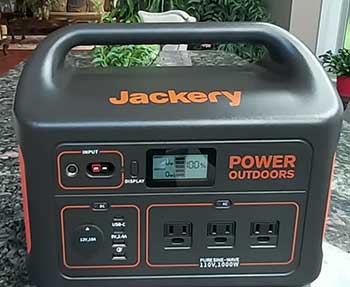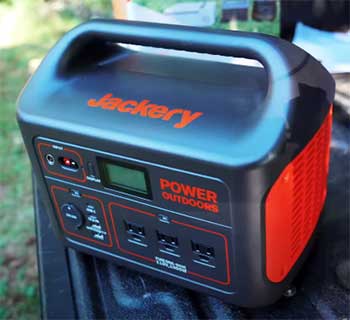Portable power stations like the Jackery 880 and 1000 are revolutionizing the world of outdoor recreation and emergency preparedness. These compact lithium-ion battery packs can power everything from mini-fridges to CPAP machines, making them the perfect power source for camping, tailgating, RVing, and power outages.
But with two great options from Jackery, how do you choose between the 880 and the 1000? In this in-depth comparison guide, we’ll look at the key specs, features, and real-world performance of both models to help you decide which Jackery power station is the best fit for your needs and budget.
A Brief Comparison Table
| Specs | Jackery 880 | Jackery 1000 |
| Battery Capacity | 882Wh | 1002Wh |
| AC Outlets | 1x 1000W | 1x 1000W |
| Portability | 22 lbs | 22 lbs |
| Dimensions | 13.1 x 9.2 x 11.1 inches | 14.4 x 10.1 x 15.6 inches |
| Output | 1000W (2000W surge) | 1000W (2000W surge) |
| Solar Input | 200W max | 200W max |
| Output Ports | 1x AC, 2x USB-A, 1x USB-C, 1x 12V car | 1x AC, 2x USB-A, 1x USB-C, 1x 12V car, 1x 12V cigarette lighter |
| Charging Methods | AC, Solar | AC, Solar, Dual AC+Solar, Generator (with adapter) |
| Display | LED indicators | LCD display screen |
| Lighting | None | Built-in light & flashlight |
| App Connectivity | No | Yes, Bluetooth |
| Price | $999 | $1299 |
Key Specs Face Off: Jackery 880 and 1000 Portable Power Station
First, let’s look at how the core specs of these two power stations stack up:
Jackery 880

- Battery capacity: 882Wh lithium-ion
- AC outlets: 1x pure sine wave 1000W AC outlet
- Portability: 22 lbs
- Dimensions: 13.1 x 9.2 x 11.1 inches
- Output: 1000W (surge 2000W)
- Solar input: 200W max
Jackery 1000
- Battery capacity: 1002Wh lithium-ion
- AC outlets: 1x pure sine wave 1000W AC outlet
- Portability: 22 lbs
- Dimensions: 14.4 x 10.1 x 15.6 inches
- Output: 1000W (surge 2000W)
- Solar input: 200W max
Both units offer lithium-ion batteries around 1000Wh, a single 1000 watt AC outlet, and 200 watts of solar input. The Jackery 1000 squeezes out just a bit more battery capacity in a slightly larger package.
But on paper, the overall power specs are quite comparable. The differences come down to extra features and real-world use.
Also Read: Differences Between Champion 2500 And Honda 2200 Generators.
Key Feature Differences
Beyond the basics, there are some key differences in features between the 880 and 1000 worth noting:
- Output ports: The Jackery 1000 adds a 12V cigarette lighter outlet, which can be handy to directly charge accessories like car refrigerators.
- Charging methods: The 1000 offers dual charging, allowing you to charge via AC and solar simultaneously to reduce downtime. The 880 can only charge one method at a time.
- Display: The 1000 packs an LCD display screen for easy monitoring of power usage and battery level. The 880 just has basic LED indicators.
- Generator charging: Both units require the Jackery SolarSaga solar panel for solar charging (sold separately). But only the 1000 can be charged from a gas generator without additional accessories.
- Lighting: The Jackery 1000 features a built-in overhead light and flashlight. The 880 has no integrated lighting.
- App connectivity: The 1000 offers Bluetooth connectivity and can be monitored via Jackery’s mobile app. No app connectivity for the 880.
The extra charging flexibility, LCD screen, lighting, and app connectivity on the 1000 make it a bit more user-friendly for powering larger loads and longer off-grid excursions. But these features aren’t necessities for more basic backup power needs.
Powering Performance & Real-World Use
Specs and features provide helpful information, but what really matters is real-world performance. Here’s how these two units stack up powering common devices and appliances.

- Phones & laptops: Both the 880 and 1000 offer plenty of battery life for keeping smartphones, tablets, and laptops powered up. Most users could get a week or more of power for small electronic devices from either model.
- Mini-fridges: Compact 12V car refrigerators around 50-60 watts can run over 24 hours on both units. For an AC mini-fridge, the 1000 provides a bit more operating time.
- CPAP machines: A typical CPAP machine draws around 30 watts. The 880 provides nearly 30 hours of use and the 1000 extends it to over 34 hours per charge.
- Small appliances: You can operate mini portable appliances like blenders, coffee makers, or portable grills for a few hours on both power stations.
- Medium appliances: The 1000 shines when it comes to medium loads like TVs, electric griddles, air pumps, or fans which may run 4-6 hours on the 880 but 6-8+ hours on the 1000.
- Large appliances: Neither unit can adequately power larger loads like full-size refrigerators or air conditioners. You would need at least a 2000Wh power station to properly operate appliances that draw 1000W or more.
- Simultaneous loads: With its slightly larger battery capacity, the 1000 can handle simultaneous loads a bit better than the 880. Try to avoid exceeding 800 watts total draw on the 880.
So for powering phones, laptops, lights, small med appliances, and mini-fridges, the 880 and 1000 are pretty comparable. But the 1000’s extra capacity provides some headroom for medium loads and running multiple things at once.
Also Read: Differences Between Jackery, Goal Zero And Anker Portable Power Stations.
Portability & Construction
When it comes to portability, the Jackery 880 and 1000 are nearly identical on paper. They both weigh in at 22 pounds and measure 13 inches or less along their longest side.
The handles and compact shape on both units make them easy to move around. The 880 is just slightly smaller in dimensions while the 1000 offers a bit more rigidity with its tough plastic shell.
Durability is excellent on both models. Jackery uses high quality lithium-ion LG or Samsung batteries inside that can handle 500+ recharge cycles. The outer case and connections stand up well to life on the road with some degree of shock and vibration resistance. Most users report years of reliable use from their Jackery power station with proper care.
For taking your power station camping or your emergency kit, the 880 fits a bit more easily into tight spaces like small cars or RVs. But both units are portable enough for most applications.
Cost Comparison
As you might expect, the extra features and capacity on the Jackery 1000 come at a higher price point:
- Jackery 880: $999
- Jackery 1000: $1299
That’s a $300 difference between the two units. You can often find them at a discounted price from third party retailers.
Given the very similar core performance for basic loads, the 880 provides excellent value at under $1000. But if your budget allows, the 1000’s additional functionality and power capacity add some nice benefits.
Either model can be a significant investment upfront. To reduce costs, you may want to start with a smaller capacity Jackery like the 500 or 240 and upgrade later if you feel you need more power.
Jackery 880 And 1000 – Which Is Better For You?
So which Jackery power station reigns supreme? Here’s a quick recap of when to choose each model:
Jackery 880 – Best for you if:
- You want excellent value under $1000
- You plan to run smaller loads like phones, laptops, mini-fridges, or medical devices
- Don’t need the extra charging ports, LCD screen, or app connectivity
Jackery 1000 – Best for you if:
- You have a larger budget and want extra capacity and features
- You need to power medium appliances or multiple things at once
- You want maximum battery life for phones/laptops and CPAP machines
- Advanced features like dual charging or generator charging are appealing
Also Read: 17TF Battery Competitors.
Frequently Asked Questions (FAQ)
The Jackery 880 can effectively run a small 12V refrigerator designed for camping and automotive use, drawing 50-60 watts. It does not have the capacity to run a full-size household AC refrigerator, which typically requires 1000+ watts.
The Jackery 880 takes around 7.5 hours to fully recharge from 0% to 100% from a wall outlet. It can recharge from solar in around 8 hours with an optimal 200W solar panel setup.
The Jackery 880 has a 1000 watt AC inverter with a 2000 watt surge capability. Its overall battery capacity is 882Wh.
The Jackery 1000 is worth the higher price over the 880 if you need the extra capacity to power medium appliances and multiple devices, take advantage of the AC/solar dual charging, or want conveniences like the LCD screen and phone app connectivity. For basic needs, the 880 provides great value at under $1000.
Final Thoughts
Both Jackery 880 and 1000 owners love the reliable power they provide off-grid and in emergencies. And each model offers sizes and features that align with different budgets and power needs.
Hopefully this detailed comparison has helped you decide which Jackery portable power station is the best choice to keep your devices powered up anywhere.

